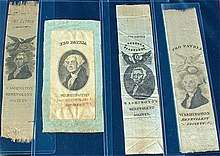Washington Benevolent Societies
The Washington Benevolent Societies (the "WBS") were grass-roots political clubs set up 1808-1816 by the Federalist Party in the U.S. to electioneer for votes. As shown on the membership certificates printed within copies of "Washington's Farewell Address" that were issued to members, the first of these societies was "instituted in the City of New York, on the 12th day of July, 1808."[1] The President of that first WBS was Isaac Sebring [perhaps the Federalist merchant described in "The Old Merchants of New York City].[2] and Secretary was G. C. Verplanck (perhaps Guilan Crommelin Verplanck, Sr.).[3] Societies were also formed in Rhode Island in 1810, as the threat of warfare loomed.[4] Citing a July 6, 1812 edition of the "Federalist" newspaper in New Jersey, it has been reported that: "Coinciding with the first state peace convention, the initial public appearance of the Washington Benevolent Society in New Jersey occurred in Trenton on July 4, 1812."[5]

The WBS helped pioneer electioneering techniques in a democracy. "The promise of participation in the parade and receipt of the badge of the Society had been used as part of the Trenton Society's membership drive, for the Federalists were interested in gaining as many members as possible."[6] Ribbon badges with George Washington's portrait and the words "Pro Patria" ("For Country") printed on silk or vellum were issued to members of the Societies. "Silk ribbons bearing Washington's portrait issued by the society are among the earliest mass-produced partisan objects in American political history."[7]
Into the Age of Jackson, an oration on Washington's birthday, February 22, was commonly delivered before the Washington Benevolent Societies in various states, and sometimes it would be printed.
Notes
- George Washington, "Washington's Farewell Address to the People of the United States," Published for the Washington Benevolent Society, New-York, Printed by J. Seymour, At Washington's Head, No. 118 Pearl-street, 1808.
- Walter Barrett, "The Old Merchants of New York City," Carleton (1862)
- Robert William July, "Essential New Yorker, Gulian Crommelin Verplanck," Durham, N.C.: Duke University Press (1951)
- William Alexander Robinson, "The Washington Benevolent Society in New England: a phase of politics during the War of 1812", Proceedings of the Massachusetts Historical Society 49(1916) pp 274ff.
- Rudolph J. Pasler and Margaret C. Pasler, "The New Jersey Federalists," p 144 (Associated University Presses, Inc., 1975) ISBN 0-8386-1525-2.
- Paslers, "The New Jersey Federalists," p. 145.
- Keith Melder, "Hail to the Candidate Presidential Campaigns From Banners to Broadcasts," p 65, Smithsonian Institution Press, Washington & London (1992) ISBN 1-56098-178-4
Secondary scholarly sources
- Harlan H. Ballard, "A forgotten fraternity," Collections of the Berkshire Historical and Scientific Society 3 (1900) pp 279–98.
- David Hackett Fischer. The Revolution of American Conservatism: The Federalist Party in the Era of Jeffersonian Democracy (1976) ISBN 0-226-25135-7